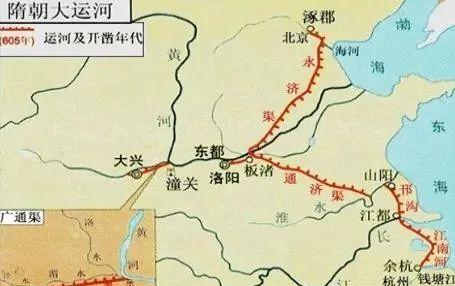Speaking of the Sui Dynasty Emperor Yang Guang, everyone has mixed praise and criticism, and in history, it is rumored that Yang Guang, in order to satisfy his extravagant and lavish life, overhauled the palace gardens and palace annexes in various places. Among them, the famous ones are Xianren Palace, Jiangdu Palace, Linjiang Palace, Jinyang Palace, Xiyuan and so on. But the extravagant monarch had repaired the city of Luoyang, improved the imperial examination system, and, more shockingly, built the world-famous Beijing-Hangzhou Grand Canal during his reign.
Many people have said that the construction of the Beijing-Hangzhou Grand Canal was for the Sui Emperor Yang Guang's greed for pleasure to go further away to find flowers and ask for willows, and from these points of view of the ancients, the original motivation of the Sui Emperor to dig the Grand Canal was only for the needs of personal "Youxing", that is, the so-called "out of the private will of the king Youxing". So what is the purpose of Yang Guang's construction of the Grand Canal? Expert: Just look at the route of the Grand Canal! Let's take a look at it together.

Route analysis
The Beijing-Hangzhou Grand Canal is about 2,000 kilometers long, reaching Zhuo County in the north, Connecting Yuhang in the south, reaching Luoyang in the east and connecting with the Guangtong Canal built in the fourth year of the Kaihuang Through the Yellow River Waterway, reaching Chang'an. It is divided into four sections: Tongji Canal, Pugou Canal, Guangtong Canal and Jiangnan River, which took more than six years to build, which can be described as a miracle on earth. It is mainly dredging the old river channels left by various dynasties from the Spring and Autumn to the Southern and Northern Dynasties. The Sui-Tang Grand Canal is mainly divided into four sections, in the first year of Daye, the Tongji Canal was repaired, which was connected from the Xiyuan in Luoyang to Huai'an, Jiangsu Province, and in the same year, the Shanyang Hangou was dredged. In the fourth year of Daye, the Yongji Canal was excavated, so that the Tongji Canal extended to the north, using the Qinshui River Channel, connecting the Yellow River to the south and Zhuo County (present-day Beijing) to the north. In the sixth year, Daye built the Jiangnan River, from Jingkou (present-day Zhenjiang, Jiangsu) through Taihu Lake to Yuhang (present-day Hangzhou) on the Qiantang River. The opening of the entire Grand Canal connects the five important water systems of the Qiantang River, the Yangtze River, the Huai River, the Yellow River and the HaiHe River, with the eastern capital Luoyang as the center, the 800-mile Qinchuan River in the west, the endless North China Plain in the north, and the Taihu Lake Basin in the south, the land of fish and rice, with a length of thousands of miles.
Important role
Historically, the Beijing-Hangzhou Grand Canal has also played a huge role in the transportation and agricultural civilization and social development of the north and south. First of all, it strengthens the transportation and exchanges between the north and the south, promotes the integration of cultures between the north and the south, facilitates the transportation of grain from the south to the north, promotes the rapid development of the cities along the coast, and provides irrigation water for the cities along the coast, while also reducing the occurrence of exceptionally large floods; secondly, the opening of the canal also strengthens the economic construction of the Jiangnan region and consolidates the central government's rule over the whole country. Until now, the Beijing-Hangzhou Grand Canal has made an important contribution to the formation of a unified Chinese economy The Beijing-Hangzhou Grand Canal has changed China's geographical environment and formed a large water network with a comprehensive range of north, south, east and west, which directly led to the economic development along the canal and the rise of the city.
Many film and television dramas have portrayed Yang Guang as a dimwitted monarch who only knows how to spend days and wine, and during his reign, he enslaved the people and made the people miserable, and finally the Sui Dynasty was destroyed in his hands, so the evaluation of him by later generations is generally not good, but some history is often based on partial generalization, the completion of the Grand Canal, is the water hub where merchants travel and soldiers must fight, and promotes the prosperity and development of both sides of the canal.
Of course, it was necessary to use some soldiers when building a large project, and the speed of construction also made everyone have an opinion on yang Guang, the Emperor of Sui, so that everyone thought that Emperor Sui was a tyrant. Through the construction of the Beijing-Hangzhou Grand Canal, we have seen the fearlessness of the Sui Emperor, which shows that the Sui Emperor's vision and boldness are very far-sighted, and he should be a generation of kings with immeasurable merit.